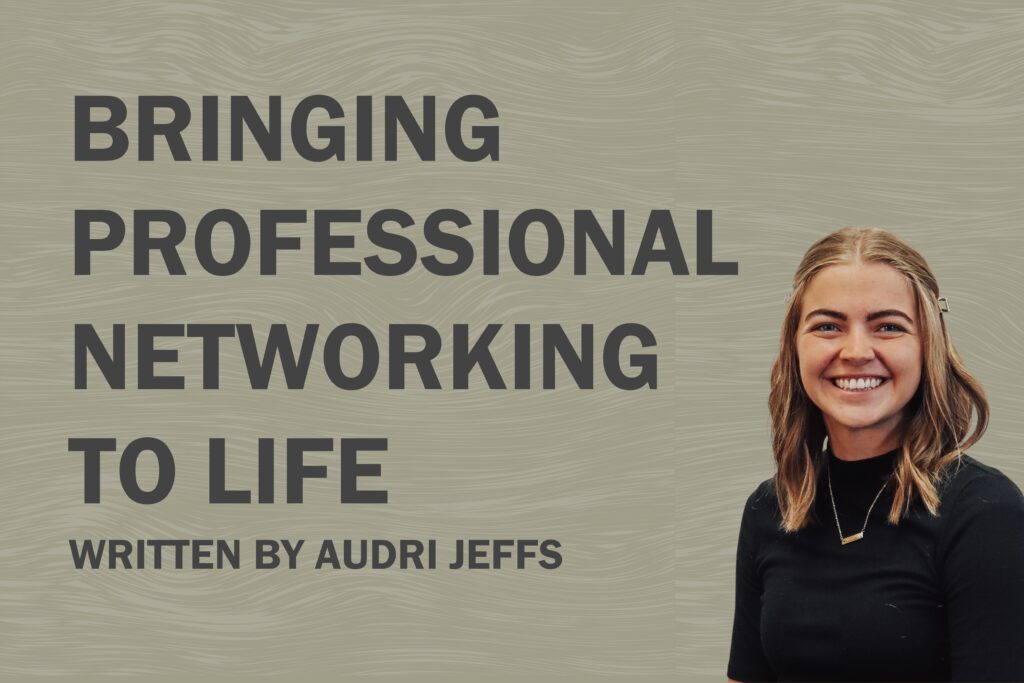Bringing Professional Networking to Life

Unexpectedly on a Tuesday morning, recent BYU graduate Courtney Nelson got a text from a friend, “There’s an email from Weber Shandwick in your inbox right now, when’s the soonest you can talk?” That email led to an interview the same day where Nelson was offered her dream position working for Weber Shandwick.
Months before, Nelson had connected with several people from the PR agency. She met with a few of them and had received tips on her resume and application. So, when a recent
intern declined the position, Courtney was on the top of their minds and immediately contacted for the interview.
For years, people would send their resumes into black holes, unavailingly hoping that they would see the light of day. Personal connections are often the answer to landing a job. Networking has become the shortcut to gaining the trust of an employer.
Nelson believes she was able to land her dream job because “somebody on the inside knew I wanted it and could tell I was eager and excited about working there.” Like Nelson, young PR professionals will stand out as they’re serious about networking in a genuine way.
So how can they do that?
Be intentional.
The first step to effective networking is to be specific with one’s personal goals. BYU Alumni Steven Pelham said to “figure out what path you want to take and then make very conscious moves to get there.” Students should take time to create and evaluate their own career goals and interests. Former national PRSSA president Andrew Cook encourages students to read PR trade industry publications such as PRovoke, PR Weekly, and PR Daily to understand the industry and discover one’s place in it. He says once one knows their top three career goals, they will be able to make intentional steps towards reaching them.
When looking for a career shift, Stephen Fortuna, current head of content and community at Eddy, knew he wanted to work in the PR tech industry. He narrowed down Qualtrics as one of his top choices, and then reached out to six professionals at Qualtrics. Once they started hiring for an internship, he had practically no competition because everyone at the company already knew him.
It’s also important for individuals to look for professionals who are talking about the topics they’re interested in. BYU professor Dr. Devin Knighton says to “be intentional about the people you connect with. Ask them questions about the topics you’re passionate about and dying to understand. Don’t engage in conversations that you would not actually be interested in talking about.” Thoughtful preparation should guide one’s decision on who to connect with and what questions to ask. Building connections will come naturally to aspiring professionals as they engage in topics they are actually interested in.
Stay within their awareness set.
Once a connection is made, it’s critical to maintain the relationship — and keep it professional. Starting small talk on LinkedIn is ineffective; one should instead seek to stay within their awareness set. Fortuna describes this marketing strategy — to stay within their awareness set — as a way to “remind them of you periodically so that they remain constantly aware of you.” He says the best way to do this is to be active on LinkedIn. Professionals will notice any likes and comments on their posts, and it is important that they see personal posts that are indicative of what the student is doing, their skillset, and personal brand.
Knighton shares a few best practices on how to follow up with professionals on things happening in their area of expertise. Students could ask questions about how a professional is handling certain world issues, send articles to hear what their opinion is, or respond to news happening at their company or in their industry. When future PR professionals take these steps, they will be amongst the first candidates to come to mind when companies start looking for someone new to hire.
Give back.
Building a professional network is not all about oneself. Andrew Cook at Weber Shandwick says that his motto when it comes to networking is to “try and give more than you take.” For students, this applies to relationships with colleagues as well as professionals. Individuals can support their connections by commenting, sharing, and recognizing their work. Networking fails when it becomes a task on the to-do list. “When it’s a task on our to-do list, then we are at risk of becoming artificial,” shared Knighton. One must think of networking as creating relationships, and relationships are two-way streets.
Knighton suggests volunteering as another way to help. Professionals will often not turn down an offer of another’s time or talents. “Sometimes, the best relationships you’ll make are with the people you serve with,” Knighton said.
PRSSA is a great way to expand one’s connections and give back. From a network of over 10,000 people, it’s an essential source to tap into. Students can get involved in networking events, National Conferences, twitter chats, and more.
Conclusion
Knighton stated it well when he said, “What networking has to be, ultimately, is about just enjoying people and loving people. And feeling that gratitude and excitement for people. And then when we want to grow and expand our network, it comes across a lot more sincere.”
Success in building a professional network comes through sincerity. PR professionals should use their communication skills and authenticity to build powerful relationships and expand their networks
Audri Jeffs is a senior at Brigham Young University studying public relations. She hopes to have a PR career that focuses on corporate social responsibility to help businesses do more good in the world. Audri is passionate about the outdoors and enjoys rock climbing, paddle boarding, slacklining, and hiking.

